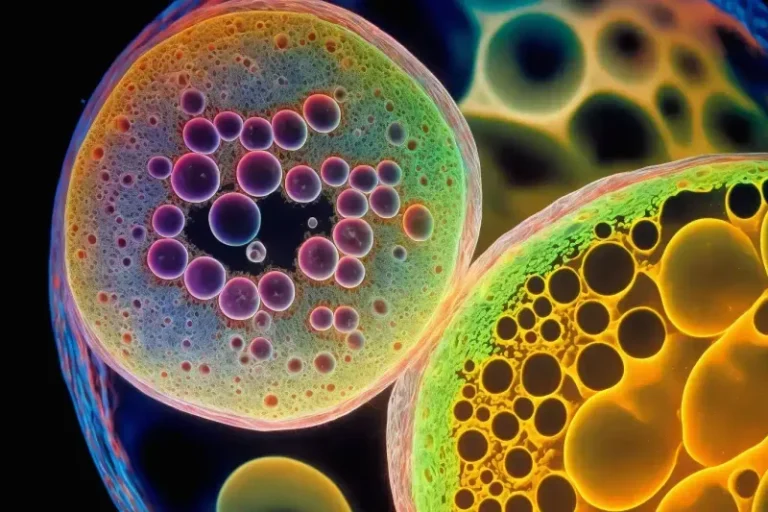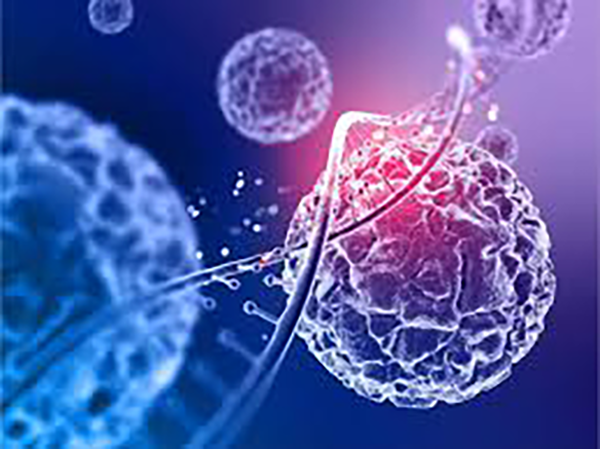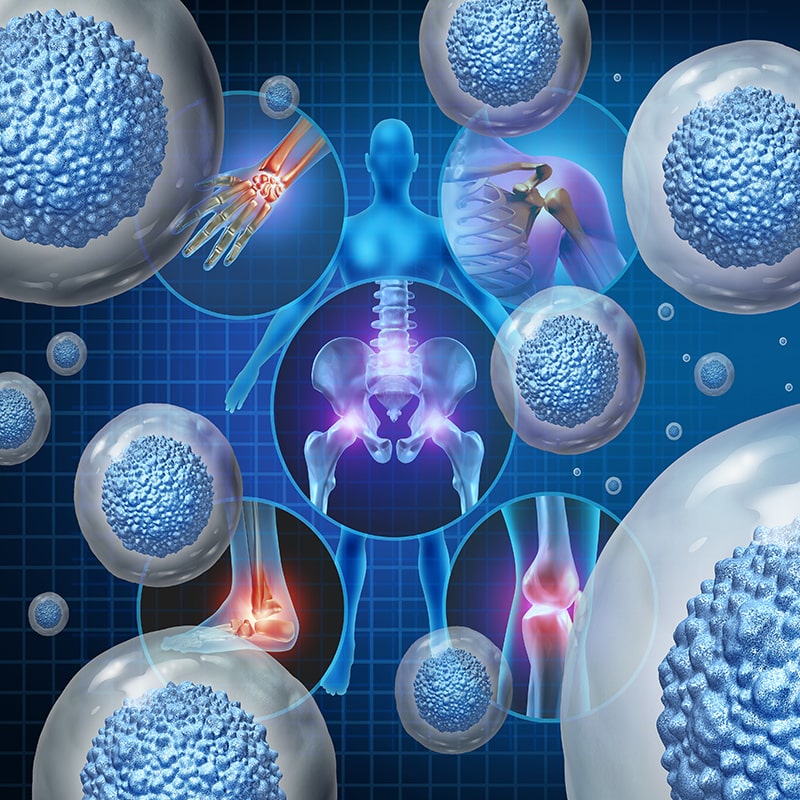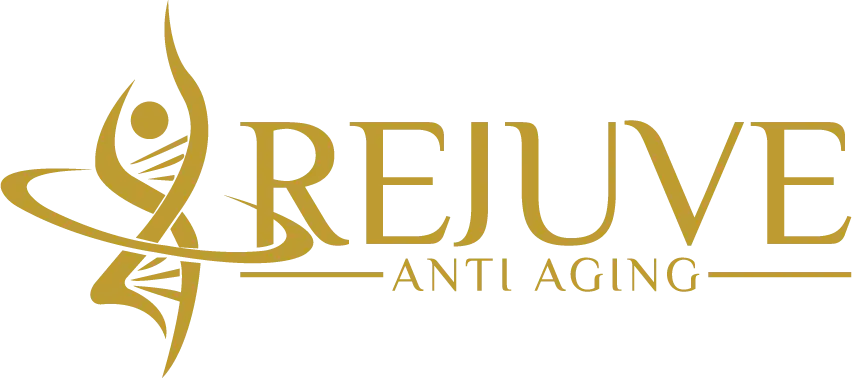STEM CELL JOINT INJECTIONS
FOOT & ANKLE PAIN
Regenerative medicine treatments may offer a superior alternative to foot & ankle surgery
Rejuve Anti Aging offers cutting-edge regenerative therapies designed to restore mobility and relieve foot and ankle pain—without surgery. Our advanced trifecta joint injections, featuring PRP (Platelet-Rich Plasma), Stem Cells, and Exosomes, provide a sophisticated, non-invasive solution for conditions such as plantar fasciitis, Achilles tendon injuries, arthritis, ligament sprains, and joint degeneration.
By harnessing your body’s natural healing power, these innovative treatments stimulate tissue repair and regeneration at the source—rather than just masking pain. Whether you’re an athlete looking to stay active, dealing with chronic foot discomfort, or seeking to maintain peak mobility as you age, Rejuve’s regenerative therapies can help restore strength, flexibility, and function.
Skip the risks and downtime of traditional foot and ankle surgeries. Rejuve Anti Aging offers ultrasound-guided stem cell injections, a precise, image-guided approach using your own Mesenchymal Stem Cells to repair damaged tissues and promote long-term healing. This advanced technique helps you stay on your feet without the complications of invasive procedures.
Rediscover the freedom of pain-free movement. Contact Rejuve Anti Aging today to explore regenerative solutions for your foot and ankle health!
Ligament Tears - Tendon Tears - Ankle Osteoarthritis
WANT THE SCIENCE & DETAILS?
DOWNLOAD MESENCHYMAL STEM CELLS INFORMATION KIT
PROVEN RESULTS
Stem cell therapy: clinically proven to reduce joint pain and improve mobility.
NATURAL & SAFE
Leveraging the body’s own processes combined with PRP, Stem Cells and Exosomes
SIMPLE 30 MIN PROCEDURE
Ultrasound guided, highly accurate joint injections without anesthesia or downtime.
100% GUARANTEE OF FOOT & ANKLE PAIN REDUCTION!
Details Available During The Consultation
Clinical Studies Of Stem Cells for Foot & Ankle Injuries
Over the past decade, research and publications on the therapeutic application of mesenchymal stem cells (MSCs) for foot and ankle injuries have significantly increased. This expanding body of work highlights the strong interest and continuous advancements in refining and optimizing this innovative treatment approach.
Recent studies have increasingly focused on understanding the precise mechanisms of MSCs, moving beyond their ability to differentiate into various cell types to explore their critical roles in paracrine signaling and immunomodulation. This deeper insight has led to more targeted and effective applications in regenerative medicine for foot and ankle conditions.
The growing number of clinical trials investigating MSC therapy for foot and ankle injuries reflects a dedicated effort to translate promising preclinical findings into real-world benefits for patients suffering from chronic pain, ligament and tendon injuries, osteoarthritis, and other degenerative conditions.
"Function improved significantly and Pain also improved in this group significantly"
Plast Reconstructive Surg
Chronic Plantar Fasciitis: A Randomized, Crossover Clinical Trial
"Significant increase of tendon thickness measured using MRI & ultrasound "
European Journal of Radiology
Stem Cells in achilles tendinopathy
"Mesenchymal stem cells demonstrated a clinically relevant improvement in outcomes"
Foot & Ankle Orthopedics
Contemporary Review: The Use of Mesenchymal Stem Cells in the Foot and Ankle

End Foot & AnklePain!
Have you been told that the only way to relieve your foot & ankle pain is through steroid injections or invasive surgery?
Research suggests that many common foot and ankle surgeries—such as procedures for tendon repairs, ligament reconstructions, and joint fusions—may not always provide better outcomes than non-surgical treatments. This raises concerns about their true effectiveness in relieving pain and restoring function.
While surgeries may be necessary in severe cases, they are highly invasive and come with significant risks. Prolonged recovery times, extensive rehabilitation, and the potential for accelerated joint degeneration can sometimes lead to more long-term complications rather than lasting relief.
At Rejuve Anti Aging, we offer advanced regenerative therapies, including PRP, Stem Cells, and Exosome treatments, as non-surgical alternatives for foot and ankle conditions. These cutting-edge solutions target the root cause of pain, promote natural healing, and may help you avoid the risks and downtime associated with surgery.
Explore your options before committing to an invasive procedure. Contact Rejuve Anti Aging to learn how regenerative medicine can help you stay active and pain-free!
Stem Cell Therapy Could Be The Exact Non-Surgical Alternative You’ve Been Waiting For!
Reclaim your active lifestyle. Rejuve Anti-Aging offers non-surgical solutions to get you back to the activities you love.
The fear is real: A sharp pain. A misstep. The fear of rolling your ankle or feeling it give way beneath you. The uncertainty with every step keeps you on edge, making even simple movements feel risky. Imagine missing out on life’s most meaningful moments—watching instead of playing with your kids, hesitating to go for a walk, or turning down invitations because you’re afraid your foot or ankle won’t support you.
For months, the pain, instability, and discomfort have held you back, making everyday activities feel like a challenge. And the looming thought of invasive surgery—with its long recovery and unpredictable results—only adds to the frustration. But what if there was another way?
At Rejuve Anti Aging, we understand how foot and ankle pain can disrupt your life. That’s why we offer cutting-edge, non-surgical regenerative solutions designed to activate your body’s natural healing process. With advanced treatments like PRP, Stem Cells, and Exosomes, we help restore stability, reduce pain, and get you moving again—without the fear of surgery.
Let us guide you toward a future of strength, confidence, and freedom. Contact Rejuve Anti Aging today to explore non-invasive solutions for your foot and ankle pain!

DO YOU HAVE SPECIFIC QUESTIONS ABOUT HOW STEM CELLS WORK?
ASK OUR SMART AI ASSISTANT
Outcomes For Foot & Ankle Stem Cell Procedures
COMMON FOOT & ANKLE CONDITIONS TREATED WITH STEM CELL JOINT INJECTIONS AT REJUVE ANTI AGING

FOOT & ANKLE JOINT HEALTH
The human body is designed to heal itself. Your body’s natural goal is repair and regeneration. A simple example is when you get a cut—your body stops the bleeding, forms a scab, and sends healing cells to close the wound.
This self-healing ability is constantly at work, even when you can’t see it. Your body is always scanning for damage and sending repair cells where they’re needed. However, certain factors influence how effectively your body can heal, including:
- Smoking habits
- Alcohol consumption
- Sleep quality and duration
- Regular physical activity
- Nutrition and digestion
- Stress management
Even with a healthy lifestyle—eating well, exercising, and getting enough rest—there are times when your body needs extra support. That’s where regenerative therapies at Rejuve Anti Aging can help. Our advanced treatments, including stem cell therapy and PRF, work with your body’s natural healing processes to restore function, reduce pain, and promote long-term wellness.
AND THAT’S WHERE REJUVE ANTI AGING CAN HELP!
REGENERATIVE MEDICINE FOR FOOT & ANKLE PAIN
Modern medicine often relies on medications that only mask pain rather than promoting true healing. Too many people are prescribed surgeries that may not effectively resolve their pain or the underlying problem.
Surgery itself is highly invasive—requiring tools that seem better suited for a construction site than the human body. That’s why it’s called surgical reconstruction. Recovery can take months or even years, and in many cases, the joint never fully feels or functions as it once did.
Joint replacement surgery introduces foreign materials into the body, which can create long-term issues. Just like your body reacts to a splinter—trying to push it out—your immune system may respond to implants with inflammation and pain, as it doesn’t recognize them as part of its natural structure.
At Rejuve Anti Aging, our regenerative therapies work with your body’s natural healing abilities. Using cutting-edge techniques, we concentrate and precisely deliver your body’s own regenerative cells to areas in need of repair, helping to restore function and reduce pain—without surgery. This approach, known as regenerative orthopedic medicine, has helped thousands regain mobility and live more active, pain-free lives.

100%
Saw improvement in pain scores in just 1 month!
120 participant results measured in 1-month follow ups following mesenchymal stem cell injections, compared to baseline.
Up to 76% Average Function Regained and Overall Pain Improvement
Frequently Asked Questions
Mesenchymal Stem Cells (MSCs) are undifferentiated cells capable of developing into diverse cell lineages. These cells maintain the capacity for self-renewal and are highly responsive to their surrounding environment. Upon receiving specific signals, they commit to differentiation pathways, transforming into specialized cells like skin, muscle, cartilage, tendon, bone, or red blood cells. Augmenting the availability of stem cells at a site of injury or damage can significantly promote optimal tissue regeneration by ensuring an ample supply of cells for repair.
Mesenchymal stem cells (MSCs) are increasingly utilized in treating a range of diseases due to their remarkable properties. These include self-renewal (the ability to create more stem cells), differentiation (the process of maturing into specialized cells with distinct form and function; for example, an MSC can develop into various cell types), anti-inflammatory effects (reducing harmful inflammation), and immunomodulation (regulating the immune system). Immunomodulation is particularly important, as MSCs can both stimulate a weak immune response and dampen an overactive one, potentially preventing the autoimmune reactions seen in many disorders. The anti-inflammatory capabilities of MSCs are crucial, as while inflammation is a natural defense mechanism, chronic or excessive inflammation can damage the body.
Extensive research, including both in-vitro (laboratory-based) and in-vivo (within a living organism) studies, has supported the safety and efficacy of MSC therapy and continues to elucidate the underlying mechanisms. This research highlights the diverse capabilities of MSCs, enabling their use in a variety of clinical settings for numerous degenerative conditions.
Emerging evidence suggests that umbilical cord tissue-derived MSCs (UC-MSCs) may possess greater potency compared to MSCs from other sources, potentially leading to enhanced clinical effectiveness.
Adult mesenchymal stem cells (MSCs) do not raise the same ethical concerns as fetal and embryonic stem cells. Both the Catholic Church and the Southern Baptist Convention have endorsed the research and therapeutic use of adult stem cells as an ethically acceptable alternative.
Advantages of Umbilical Cord Tissue-Derived Mesenchymal Stem Cells (UC-MSCs)
Umbilical cord tissue-derived mesenchymal stem cells (UC-MSCs) offer several advantages over other sources of MSCs, such as bone marrow-derived MSCs (BM-MSCs) and adipose-derived stem cells (ASCs):
Superior Proliferation: UC-MSCs exhibit a significantly higher proliferation rate in vitro (in a laboratory setting) compared to BM-MSCs and ASCs. This allows for more efficient expansion to obtain the large cell numbers needed for therapeutic applications.
Non-Invasive Harvesting: The collection of UC-MSCs is non-invasive. The cells are obtained from ethically donated umbilical cord tissue after birth, a process that poses no risk or discomfort to either the mother or the newborn. This contrasts with BM-MSC harvesting, which requires a bone marrow aspiration, and ASC harvesting, which typically involves liposuction.
Enhanced Secretion of Beneficial Factors: UC-MSCs secrete a variety of growth factors, cytokines, and chemokines. These secreted factors play a crucial role in tissue repair, reducing inflammation, and modulating the immune system.
Differentiation Potential: Like other MSCs, UC-MSCs can differentiate into various cell types, contributing to tissue regeneration.
Upregulated Genes: Research indicates that certain genes associated with cell proliferation (e.g., EGF), signaling pathways involved in cell survival and growth (e.g., PI3K-NFkB pathway via TEK), and neurogenesis (e.g., RTN1, NPPB, NRP2) are upregulated (have increased activity) in UC-MSCs compared to BM-MSCs. This suggests a potentially greater capacity for tissue repair and regeneration.
Yes! In recent years, several regenerative medicine treatments have been introduced into clinical practice for pain management and orthopedic care. These treatments utilize adult stem cells, making them non-controversial. The available procedures include:
- Platelet-Rich Plasma (PRP) Therapy
- Mesenchymal Stem Cell-Rich Injections
- Bone Marrow-Derived Stem Cell Injections
- Fat-Derived Stem Cell Injections
Regenerative medicine may offer benefits for various medical conditions, including:
- Joint arthritis
- Tennis elbow (lateral epicondylitis)
- Golfer’s elbow (medial epicondylitis)
- Rotator cuff tendonitis
- Ligament sprains
- Fractures
- Tendon injuries
- Cartilage defects
- COPD
- Kidney failure
- Stroke
- Multiple sclerosis (MS) and amyotrophic lateral sclerosis (ALS)
- Dementia
- Erectile dysfunction
- Heart failure
- Diabetes
- Diabetic neuropathy
MSCs possess immunosuppressive properties, reducing the likelihood of immune rejection compared to other foreign cells. Umbilical cord tissue-derived MSCs (UC-MSCs) are particularly immune-privileged, meaning they are universally accepted by the recipient’s body with virtually no risk of rejection. This is because UC-MSCs are essentially “new” and haven’t been “claimed” by a specific immune system. Unlike organ transplantation, UC-MSC therapy doesn’t require blood products or HLA matching.
Regenerative medicine procedures are generally not covered by insurance. While some surgical applications may have billing codes, most treatments are considered out-of-pocket expenses.
The price range for regenerative medicine injections is broad, typically between $1,500 and $7,500.
Our protocol is designed to significantly reduce chronic low-grade inflammation over an extended period. Stem cells possess a unique ability to target areas of inflammation in the body. Research indicates that they can regenerate damaged or diseased tissues, decrease inflammation, and regulate the immune system—contributing to improved health and overall quality of life.
Studies suggest that mesenchymal stem cells (MSCs) may have a positive impact on various conditions, including:
- ALS
- Alzheimer’s disease
- Autoimmune disorders
- COPD and other degenerative/inflammatory lung diseases
- COVID-19 (acute and long-haul)
- Chronic inflammation
- Crohn’s disease
- Type 1 diabetes
- Heart failure and heart disease
- Kidney disease
- Liver disease
- Lupus
- Lyme disease
- Multiple sclerosis
- Degenerative neurological conditions
- Neuropathy
- Parkinson’s disease
- Reflex Sympathetic Dystrophy (RSD) / Complex Regional Pain Syndrome (CRPS)
- Rheumatoid arthritis
- Spinal cord injuries
- Stroke (ischemic and hemiplegic)
- Traumatic brain injury (TBI)
Our protocol aims for long-term stabilization of the condition with a single treatment. Follow-up treatments are not required. While some patients choose to return for additional treatments, typically seeking further improvement, generally one treatment is sufficient for most degenerative conditions.
Patients generally report minimal discomfort during treatment, often describing the experience as painless.
While individual responses vary, many study participants report noticeable improvements within 1-3 months after treatment. These improvements are evidenced by reduced systemic inflammation and increased vitality, as measured by follow-up questionnaires. Some patients report improvements in symptoms and quality of life even sooner, within the first few days post-treatment.
Umbilical cord-derived mesenchymal stem cells (UC-MSCs) are particularly effective for systemic delivery via intravenous infusion. Their optimal size (17-19 micrometers) allows for efficient passage through the circulatory system, including the lungs. Although a portion of MSCs may initially be trapped in the lungs (a phenomenon known as the pulmonary first-pass effect), this does not negate their therapeutic benefits. MSCs possess a remarkable homing ability – they can actively migrate to damaged tissues. Even while temporarily in the lungs, MSCs exert beneficial paracrine effects: they secrete growth factors and other molecules that reduce inflammation and stimulate tissue repair. Advances in research are continually enhancing the delivery and efficacy of MSCs for regenerative therapies.
Potential of Stem Cells in Anti-Aging and Rejuvenation
Current research suggests that stem cell therapies may have the potential to mitigate some effects of aging and improve overall healthspan. Stem cells, particularly mesenchymal stem cells (MSCs), possess properties that could contribute to this, including their ability to:
- Repair damaged tissues: Stem cells can differentiate into various cell types, potentially replacing aged or damaged cells.
- Reduce inflammation: Chronic inflammation is a key contributor to age-related decline, and MSCs have anti-inflammatory effects.
- Modulate the immune system: MSCs can help regulate immune function, which often declines with age.
- Homing Capability: Stem cells can migrate to sites of damage or inflammation.
The concept of a “protective shield” created by stem cells and anti-aging genes is a simplified representation of these complex biological processes. While a complete reversal of aging is not currently feasible, studies suggest that stem cell interventions, potentially in combination with therapies targeting aging-related genes, could contribute to a healthier and potentially longer lifespan. It’s crucial to understand that this is an area of ongoing research, and many claims about “anti-aging” stem cell treatments are not yet supported by robust clinical evidence.
Potential Benefits of Stem Cell Therapy (Observed and Reported):
Some reported benefits of stem cell therapies, particularly in the context of age-related decline, include:
- Increased energy and vitality
- Improved physical capacity and endurance
- Improved hair quality and thickness
- Enhanced libido
- Pain reduction
- Increased strength, balance, and overall mobility
- Enhanced immune function
- Overall improvement in quality of life
- Reduced inflammatory markers
Mesenchymal stem cells (MSCs) are not a cause of graft-versus-host disease (GVHD); in fact, they are being investigated as a potential treatment for this condition. GVHD is a serious complication that can occur after allogeneic hematopoietic stem cell transplantation (typically bone marrow or cord blood transplants), where the donor’s immune cells (T-cells) attack the recipient’s tissues.
MSCs possess immunomodulatory properties that make them promising candidates for GVHD therapy. They achieve this through several mechanisms, including:
- Secretion of bioactive molecules: MSCs release proteins, peptides, and hormones that can suppress the immune response.
- Mitochondrial transfer: MSCs can transfer mitochondria (the energy-producing components of cells) to damaged cells, potentially aiding in tissue repair.
- Exosome and microvesicle release: MSCs release small vesicles containing RNA and other molecules that can influence the behavior of recipient cells, including immune cells.
While many studies suggest that MSC therapy can be beneficial for both acute and chronic GVHD, more extensive, large-scale, randomized controlled trials are needed to definitively confirm these findings and establish optimal treatment protocols.
It is important to clarify a distinction: although MSCs can modulate the activity of immune cells like T-lymphocytes and B-lymphocytes (reducing their proliferation and secretion of inflammatory factors), they are not broadly immunosuppressive in the same way as traditional immunosuppressant drugs. They have targeted immunomodulatory effects, rather than causing widespread immune suppression. This targeted effect is one reason they are promising for treating GVHD.
Follow-up vitality questionnaires indicate that approximately 85% of patients report sustained improvement in their condition within three months of treatment.
